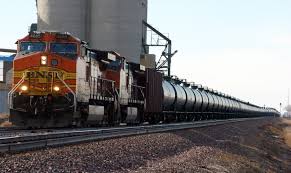
The move to create heavier and stronger rail tank cars such as those that carry oil through Oklahoma has led to a battle developing between Burlington Northern Santa Fe and the oil industry.
Burlington Northern Santa Fe has started charging oil companies and refineries a premium to use refurbished cars on its tracks. The rail way made the move after Congress ordered rail tank cars to be improved to increase safety and prevent catastrophies like the deadly derailment a few years ago in Canada..
But BNSF balked after one of the retrofitted cars crashed in Iowa this summer and spilled more than 230,000 gallons of crude, according to a report in the Houston Chronicle. The oil industry contends the rates are 30 percent higher for their oil to be carried on the retrofitted cars.
The jump in rates is part of a fight between railroads and the oil industry that comes as pipeline shortages force oil companies to turn to other means of transport to move record crude production to market. In less than 16 months, the latest in a series of older models of tank car that Congress deemed not safe enough to run on the nation’s rail network must be phased out of service.

“The bottom line is in order to meet these deadlines we have to have both new and retrofitted cars,” said Mike O’Malley, president of the Railway Supply Institute, a trade group representing rail car builders. “If you just rely on new cars, it’ll be extremely difficult to meet these deadlines.”
Ultimately, the railroads’ resistance to retrofitted cars could cost energy companies more to ship their crude across the nation’s railways and force them to scrap relatively new tank cars that otherwise might have decades more of service.
A BNSF spokesman said that as contracts with shippers expire, the railroad would seek agreements requiring the exclusive uses of the new DOT117J tank cars. Railroads don’t own the cars themselves; they are owned by shipping firms or the oil companies themselves.
“We believe the DOT117J is the appropriate tank car to safely move crude oil in unit trains,” the spokesman said in an email. “Tank car lessors and builders are getting this message and will bring more DOT117J online.”
Oil train use has declined from the boom year of 2014, but places such as the Permian Basin in West Texas, Bakken shale in North Dakota and Alberta oil sands in Canada remain reliant on rail as they wait for the completion of new pipelines. After years of decline, oil train traffic is starting to tick up again, according to the Energy Department. In September, more than 16.3 million barrels of crude were moved by rail, almost double that of the same month the previous year.
Those in the oil sector argue that Congress approved the retrofitted cars on the understanding that replacing tens of thousands of tank cars, many relatively new, was not feasible.
“Congress deemed these cars safe. (The Transportation Department), after extensive economic and risk analysis, did too, and based on its decision, over 16,000 tank cars have been retrofitted to meet the robust safety standards,” Rob Benedict, a senior director at refining trade group American Fuel and Petrochemical Manufacturers, said in a statement.



